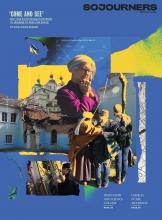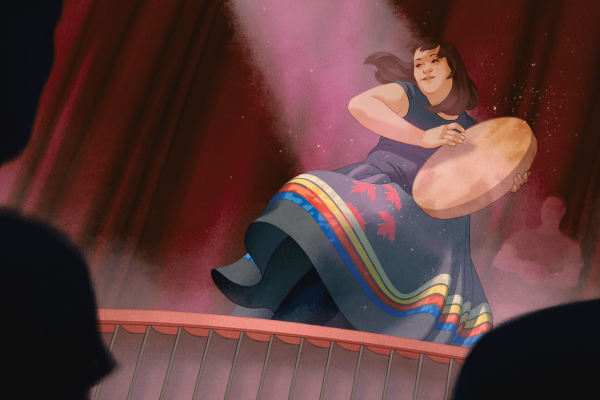This article is adapted with permission from Becoming Kin: An Indigenous Call to Unforgetting the Past and Reimagining Our Future by Patty Krawec. © 2022 Broadleaf Books.
I WAIT AT the back of the stage, behind the curtains, holding my hand drum and listening to the low buzz of a theater filled with people. My friend Karl stands in the darkness at center stage, waiting for me to start singing and make my way to where he stands. We are providing an opening for the Niagara Performing Arts Center’s season preview. It is not a Native event. The center is a public arts venue that showcases a wide range of performers, and the artistic directors include Native artists throughout the regular season. They have asked Karl and me to open this particular night as an acknowledgment that this and future events take place on Haudenosaunee and Anishinaabe land.
It is fall 2017, 150 years since Canada’s confederation, and I’ve made a ribbon skirt to wear at this event. Ribbon skirts—long cotton skirts embellished with rows of ribbon and sometimes with appliqued designs—are a contemporary innovation of an older style of clothing that we wore before settler contact. The ribbon skirt I’ve made for this evening is black with wide ribbons in the colors associated with the medicine wheel: red, black, white, and yellow. I have appliqued red maple leaves falling down the front of the skirt until they are covered by ribbons. I like the imagery of Canada being absorbed by Indigenous ideas. Later, during the gathering after the event, a couple of women will come to speak with me. They will comment that the leaves are upside down. A nation in distress flies their flag upside down, I will tell them. And Canada, like the United States, is a nation in distress.
There is the beat of the drum in that darkened theater and then my voice coming from the back of the stage. I move toward the front, singing each verse louder as the lights come up. When I finish, Karl speaks the words of the Haudenosaunee Thanksgiving Address in Oneida. Then we simply leave the stage. Not explaining the song or our actions or our words is deliberate. We let the audience sit for moment and consider that what feels profoundly alien to them is not alien at all. For one brief moment, they are surrounded by the sounds of this place.
That evening before we go on stage, Karl and I talk about whether Christianity and Indigenous worldviews can ever be reconciled, if there is any common space. He doesn’t think so. Karl is Oneida and part of the Haudenosaunee Confederacy. Hundreds of years ago, when it became evident that the newcomers were going to stay, he says, the Confederacy made a treaty with the settlers called the Two Row. This is written in the form of a wampum belt made of oblong purple and white beads, with two white rows on a purple background. The agreement was that we would travel together, the Indigenous peoples and the settlers, each in our own boat but on parallel paths in a relationship guided by peace, honesty, and respect.
The principle of noninterference lives at the root of many Indigenous philosophies and is exemplified in treaties like the Two Row: We would live according to our ways, and the newcomers would live according to theirs. Although colonization is clearly a violation of this treaty, the Haudenosaunee people I know remain committed to it and continue to try to live within these principles.
Read the Full Article

